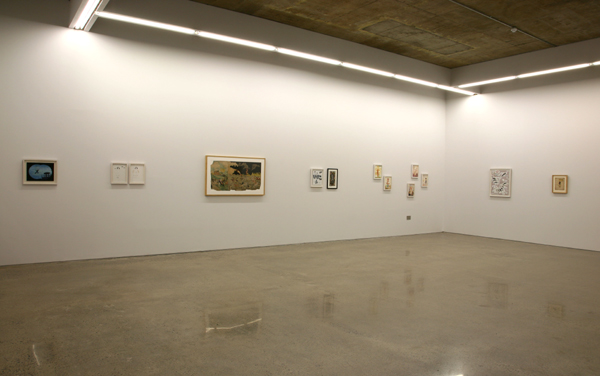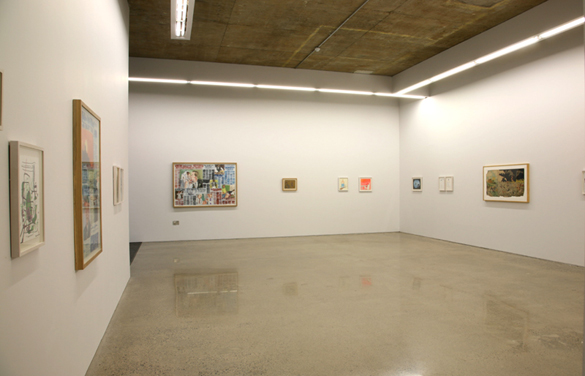(<--
back)
text|images
The World Needs A Narrative
Karin Brunnermeier, Henry Darger, Neil
Farber, Tony Fitzpatrick, Michael Kalmbach
Basim Magdy, Jason McLean, Guy Richards Smit & Ken Solomon
co-curated by Kevin Kavanagh and Jacqui McIntosh
Kevin Kavanagh Gallery, Dublin - 26 September 2008 - 18 October 2008
The World Needs A Narrative
features works on paper by nine artists for whom the art of storytelling is
central. The stories that they recount are varied – from autobiographical,
psychological and fantastical modern day fables to sociological commentary
and political satire.


Installation
views, The World Needs A Narrative, Kevin Kavanagh Gallery, 2009
Karin Brunnermeier’s
drawings, sculptures and installations could be viewed as a series of intricate
portraits. Brunnermeier's characters and the stories that she creates around
them, are based on the real and imagined and are central to the understanding
of her work. Sometimes darkly humourous, melancholic, surreal or symbolic,
her interest is in the human psyche and moments of 'fracture', where injuries,
both physical and emotional occur.
Henry Darger was born in Chicago in 1892. Darger lived a solitary life, working as a janitor in a Chicago hospital from around the age of thirty until his retirement in 1963. During this time Darger created the work for which he is now known. Alone in his room, unknown to those around him, he gave tangible, visible form to an epic story of legions of pre-pubescent girls—with paper-doll faces and unexpected male organs—who battle for their lives against monstrous foes who seek to torture, kill or exploit them. This, his magnum opus, is commonly referred to as In the Realms of the Unreal, although Darger’s actual title is The Story of the Vivian Girls, in what is known as the Realms of the Unreal, of the Glandeco-Angelininian War Storm, Caused by the Child Slave Rebellion, and spans over 15,000 single-spaced typewritten pages. This expansive, complex narrative together with over 300 imaginatively constructed fantasy drawings have come to be regarded as one of the 20th century’s most original and unusual literary works.
Neil Farber´s surreal, obscure imagery with its varicoloured overpopulation of tiny people, frogs, rats, snakes, captured maidens, dragons, cats and ghosts belongs on the border line between childhood fear and grown-up fantasy and act as the basis for a dramatic description of the darker aspects of the human psyche. Aspects, which are disturbing and upsetting – perhaps even nightmarishly evil – but nonetheless serve as an integrated part of our identity.
Tony Fitzpatrick's prints, drawings and collages are deeply autobiographical, defined, in part, by the gritty character of a working-class Chicago upbringing. His style is both dense and delicate, packed with fanciful imagery of animals and people. Fitzpatrick's art typically blends cartoon-like drawings and found images such as baseball cards and matchbooks with poetic or narrative description. His stories, sometimes real sometimes imagined, involve monsters, call girls and gamblers - monsters, madness and vice - “the stuff they don’t put in the travel brochures” according to Fitzpatrick.
Michael Kalmbach’s watercolours and plaster sculptures have focused
on the themes of family and childhood. Based on detailed original stories,
his watercolours are populated with children and cherubs in dream-like states
of weightlessness. Kalmbach’s picture worlds are anarchic and often politically
incorrect, the more so since his protagonists are often children. But the
fantasies which he realises in his pictures, sculptures and installations
closely resemble those of children, growing up freely, filled with curiosity,
tenderness but also cruelty.
Basim Magdy works with imagery derived from the mass media - images
of conflict from TV, films, computer games and propaganda and the like- translating
them, and finally reinterpreting them via the painting medium. Magdy’s
generation never experienced war directly, instead growing up amidst naïve
surrogates: violent toys – guns, knives, robots, tanks, soldiers, and
computer games abound. Magdy capitalizes on the media-driven language, translating
its imagery into contrived, attractive paintings, using a hyper-real aesthetic
replete with bright, synthetic colours and simplistic motifs. He uses paint
to question and redefine official versions of heroism, patriotism and collective
memory.
The drawings of Vancouver based artist Jason McLean are heavily punctuated by humour, slogans and references to the mundane but specific details of everyday life. His frank impressions invite audiences to reconsider everyday experience as a dense psychological construct that unfolds over time and cannot be reduced to a single iconic image. His works could be seen to represent a mental space where the artist re-elaborates the flow of information which lays siege to us every day, a map of the neighbourhood as an urban space in flux.
Guy Richards Smit’s latest works create a stream of current political commentary, sexual innuendo and satire. As part of a larger ongoing series, Smit uses the layout of the cover and inside pages of The New York Times as the template for his watercolours and oils. Through headlines and article topics, Smit conveys his sharply observant cultural and political message. In these new works, Smit has directed his gaze firmly at the American political scene, his works undercut with philosophical observations and humour.
Ken
Solomon’s recent work has explored the imagery and iconography of
the U.S. postal system. At VOLTA NY 2008 Solomon set up an early voting bureau
for the US Presidential elections, creating his own hand painted stamps of
the Democratic and Republican nominees Barack Obama, Hillary Clinton, Mike
Huckabee, John McCain, and Ralph Nader. He subsequently printed hundreds of
sheets of stamps for the public to cast their vote. A meshing of mathematics
and whimsy, for his envelope art works he uses an intensive process, pushing
repetition to examine nuance. When each piece is finally complete the envelopes
are subsequently mailed and disseminated to reconvene at the gallery, in certain
instances having been on a long journey though the intricacies and idiosyncrasies
of the US postal system. Solomon plays precise control and uncertainty together,
allowing for third party mark making (the stamps, stickers or marker lines
added by the post office) and the possibility of works getting lost. Each
piece has its own special journey and individual story.
(<--
back)
text|images